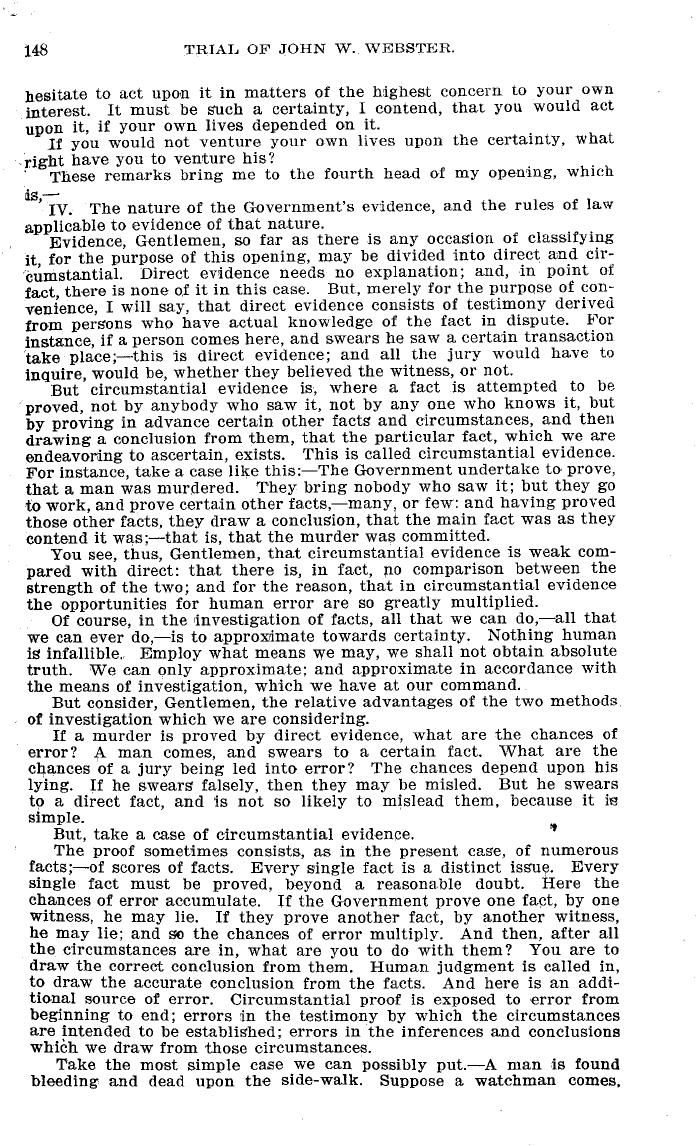|
1˘Ei TRIM. OF JOHN W. WEBSTER.
hesitate to act upon it in matters of the highest concern to your own
interest. It must be such a certainty, I contend, that you would act
upon it, if your own lives depended on it.
If you would not venture your own lives upon the certainty, what
-right have you to venture his?
These remarks bring me to the fourth head of my opening, which
ds,--
IV. The nature of the Government's evidence, and the rules of law
applicable to evidence of that nature.
Evidence, Gentlemen, so far as there is any occasion of classifying
it, for the purpose of this opening, may be divided into direct and cir-
cumstantial. Direct evidence needs no explanation; and, in point of
fact, there is none of it in this case. But, merely for the purpose of con-
venience, I will say, that direct evidence consists of testimony derived
from persons who have actual knowledge of the fact in dispute. For
instance, if a person comes here, and swears he saw a certain transaction
take place; this is direct evidence; and all the jury would have to
inquire, would be, whether they believed the witness, or not.
But circumstantial evidence is, where a fact is attempted to be
proved, not by anybody who saw it, not by any one who knows it, but
by proving in advance certain other facts and circumstances, and then
drawing a conclusion from them, that the particular fact, which we are
endeavoring to ascertain, exists. This is called circumstantial evidence.
For instance, take a case like this: The Government undertake to prove,
that a man was murdered. They bring nobody who saw it; but they go
to work, and prove certain other facts,-many, or few: and having proved
those other facts, they draw a conclusion, that the main fact was as they
contend it was; that is, that the murder was committed.
You see, thus, Gentlemen, that circumstantial evidence is weak com-
pared with direct: that there is, in fact, no comparison between the
strength of the two; and for the reason, that in circumstantial evidence
the opportunities for human error are so greatly multiplied.
Of course, in the investigation of facts, all that we can do,-all that
we can ever do,-is to approximate towards certainty. Nothing human
is infallible.. Employ what means we may, we shall not obtain absolute
truth. We can only approximate; and approximate in accordance with
the means of investigation, which we have at our command.
But consider, Gentlemen, the relative advantages of the two methods,
of investigation which we are considering.
If a murder is proved by direct evidence, what are the chances of
error? A man comes, and swears to a certain fact. What are the
chances of a jury being led into error? The chances depend upon his
lying. If he swears falsely, then they may be misled. But he swears
to a direct fact, and is not so likely to mislead them, because it 10
simple.
But, take a case of circumstantial evidence. "
The proof sometimes consists, as in the present case, of numerous
facts; of scores of facts. Every single fact is a distinct issue. Every
single fact must be proved, beyond a reasonable doubt. Here the
chances of error accumulate. If the Government prove one fact, by one
witness, he may lie. If they prove another fact, by another witness,
he may lie; and so the chances of error multiply. And then, after all
the circumstances are in, what are you to do with them? You are to
draw the correct conclusion from them. Human judgment is called in,
to draw the accurate conclusion from the facts. And here is an addi-
tional source of error. Circumstantial proof is exposed to error from
beginning to end; errors in the testimony by which the circumstances
are intended to be established; errors in the inferences and conclusions
which we draw from those circumstances.
Take the most simple case we can possibly put.-A man is found
bleeding and dead upon the side-walk. Suppose a watchman comes,
|

